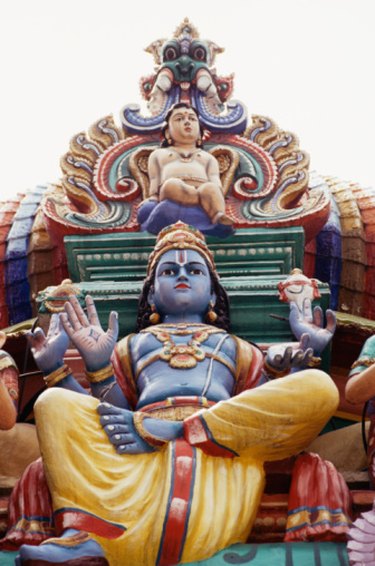
When Hindus celebrate and honor their deities, they surround themselves with pictures or statues of the divine and offer cleanliness and purification rituals. Some festivals, such as Diwali, welcome gods and goddesses into homes with ceremony and sacred worship called puja. A Hindu purification process incorporates chanting with elements, such as water, foodstuffs, images of the deities and flowers.
Home Purification
Video of the Day
Diwali festival celebrants throw open their windows and doors to invite the Hindu goddess, Lakshmi, into homes cleansed and purified in anticipation of the goddess' blessings of prosperity. Lakshmi devotees perform a ritual house cleaning with worshiping brooms for this specific purpose. Since the goddess visits the cleanest home first, Lakshmi worshipers are diligent in their efforts to welcome the goddess.
Video of the Day
Puja Room Purification
The deities must be prepared for puja. Devotees perform ritual cleansing for Lakshmi and Lord Ganesha as part of pujas to the goddess and the god. Worshipers clean the sacred space where the deities' images reside and where worship occurs. Then devotees bathe the god and the goddess with water and rose water.
Deities' Preparation
Once the deities' images are purified, Hindus faithful to Lakshmi and Ganesha place lamps in front of the images to ward off evil. Devotees appease the god and goddess with gifts of prasad, sacred food, including milk, ghee and fruits. Offerings of flowers, incense and spices complete Lakshmi and Ganesha puja purification and preparation.
Puja
After the devotees' homes are cleansed, the puja room is purified and the deities are prepared, faithful Hindus perform puja to Lord Ganesha first. He is worshiped before all the deities, according to Diwali custom. The god and then the goddess receive more flowers. Devotees offer the deities their own songs, called aarti. The Ganesha and Lakshmi pujas complete the worship and preparation for the god and the goddess central to many Diwali celebrations.